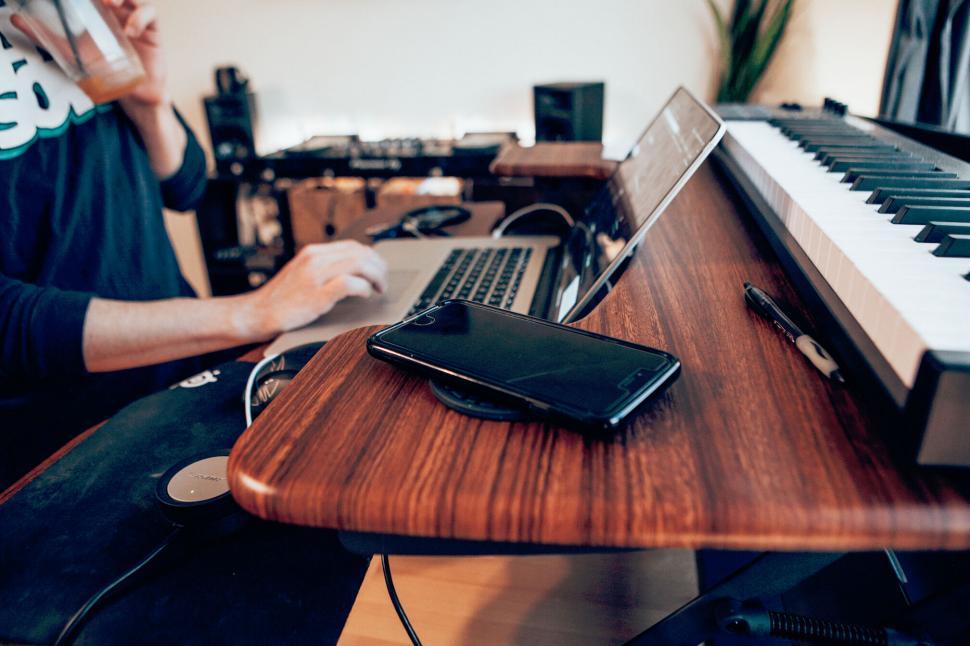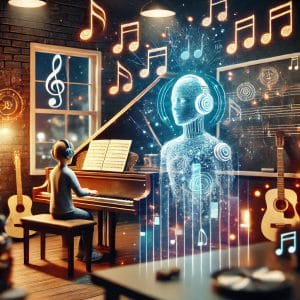
AI in Music Education: Balancing Technology with Creativity
The world of music education technology is evolving rapidly, with artificial intelligence in music playing a significant role in shaping how students learn and engage with their instruments. From AI-driven composition tools to personalised learning apps, technology in music education is providing students with new ways to develop their skills. However, while AI offers benefits like real-time feedback and custom lesson plans, there are concerns about how it might impact creativity and the traditional human-led learning experience.
At Top of the Rock Tuition, we believe that while music artificial intelligence can enhance the learning process, it should be used as a complement to – not a replacement for – the personal touch of a skilled teacher. In this blog, we’ll explore how AI is changing technology in music education, the advantages and limitations it brings, and how students and teachers can find the right balance between innovation and artistic expression.
How AI is Transforming Music Education
1. Personalised Learning Paths
One of the biggest advancements in music education technology is AI-driven learning platforms. Apps like Yousician and Simply Piano use artificial intelligence in music to analyse a student’s playing and provide real-time feedback. These tools adjust exercises based on a learner’s progress, ensuring that each student gets a personalised experience tailored to their strengths and weaknesses.
For example, if a student struggles with chord transitions on the guitar, AI-powered apps can recommend targeted exercises or slow down song tempos to make practising more manageable. This level of personalisation allows students to progress at their own pace, making learning more efficient and engaging.
2. AI-Generated Composition and Accompaniment
Another exciting development in technology in music education is AI-generated composition. Platforms like AIVA and Google’s Magenta use music artificial intelligence to create melodies, harmonies, and even full compositions based on user input. These tools allow students to experiment with different styles and musical structures, making songwriting more accessible.
Additionally, AI-powered accompaniment software can generate backing tracks in any key or tempo, allowing students to practice with realistic instrumental arrangements. This feature is particularly useful for solo musicians who want to simulate playing in a band or orchestral setting.
3. Virtual Tutors and AI-Powered Feedback
Traditionally, music students rely on teachers for guidance, but AI is now capable of providing detailed feedback. Smart apps use artificial intelligence in music to assess a student’s timing, pitch, and technique, helping them identify mistakes and improve.
For instance, an AI-driven tool might detect if a pianist is using improper hand positioning or if a singer is slightly off-key. While this feedback can be incredibly valuable, it lacks the depth and personal encouragement that a human teacher provides.

The Limitations of AI in Music Education
Despite its impressive capabilities, music artificial intelligence has several limitations that students and educators should be aware of:
1. Lack of Emotional Intelligence
Music is more than just hitting the right notes – it’s about expression, storytelling, and feeling. While technology in music education can help with technical accuracy, it cannot teach students how to convey emotion through their playing. Human teachers can provide insights on phrasing, dynamics, and interpretation that AI simply cannot replicate.
2. The Risk of Over-Reliance on Technology
One of the potential downsides of music education technology is that students may become overly dependent on AI feedback. If an app constantly corrects mistakes, students might not develop their own problem-solving skills or the ability to self-assess. Learning music involves trial and error, persistence, and personal growth – qualities that AI cannot replace.
3. The Human Connection in Music Learning
A significant part of music education is the relationship between teacher and student. Many students find inspiration and motivation through one-on-one interactions with their tutors. AI lacks the emotional intelligence and intuition that human teachers bring, making it essential to keep traditional lessons at the core of music education.
4. AI Can’t Replace Live Performance Experience
No matter how advanced music artificial intelligence becomes, it cannot replicate the experience of live performance. Playing in front of an audience, collaborating with a band, or responding to the dynamics of a live setting are skills that can only be developed through real-world practice.
Finding the Right Balance: How to Use AI Without Losing Creativity
Since artificial intelligence in music is here to stay, the key is to find ways to integrate it into learning without losing the artistic and human elements of music. Here’s how students and teachers can use technology in music education effectively:
1. Use AI as a Tool, Not a Teacher
AI can be a fantastic supplement to music lessons, but it shouldn’t replace human instruction. Students should use AI apps for additional practice while relying on teachers for deeper musical understanding and artistic guidance.
2. Set Limits on AI Assistance
While AI-generated compositions and backing tracks are useful, students should also be encouraged to create their own music without digital assistance. Teachers can challenge students to compose melodies or analyse pieces using traditional methods.
3. Encourage Live and Group Learning
No AI tool can replace the experience of playing music with others. Students should participate in group lessons, jam sessions, and live performances to develop essential musical and social skills.
4. Focus on Emotional Expression
Rather than just striving for technical perfection, students should explore the expressive side of music. Teachers can demonstrate different interpretations of the same piece, discuss the emotions behind compositions, and encourage students to experiment with phrasing and dynamics.
5. Keep the Human Element Central
At its core, music is about connection – whether it’s between a teacher and student, a performer and audience, or bandmates working together. Music artificial intelligence should be seen as a tool that enhances learning, not a replacement for human creativity and interaction.
Final Thoughts
AI is undeniably reshaping music education technology, offering new ways for students to learn, practice, and compose. However, the most valuable aspects of music education – creativity, expression, and human connection – must remain at the heart of the learning experience.
At Top of the Rock Tuition, we embrace technology in music education while maintaining a strong focus on traditional teaching methods. By using AI as a supportive tool rather than a replacement for human instruction, students can develop both their technical abilities and artistic expression.
Are you looking for music lessons that combine the best of tradition and innovation? Get in touch with Top of the Rock Tuition today to start your journey with expert guidance and cutting-edge learning tools.
